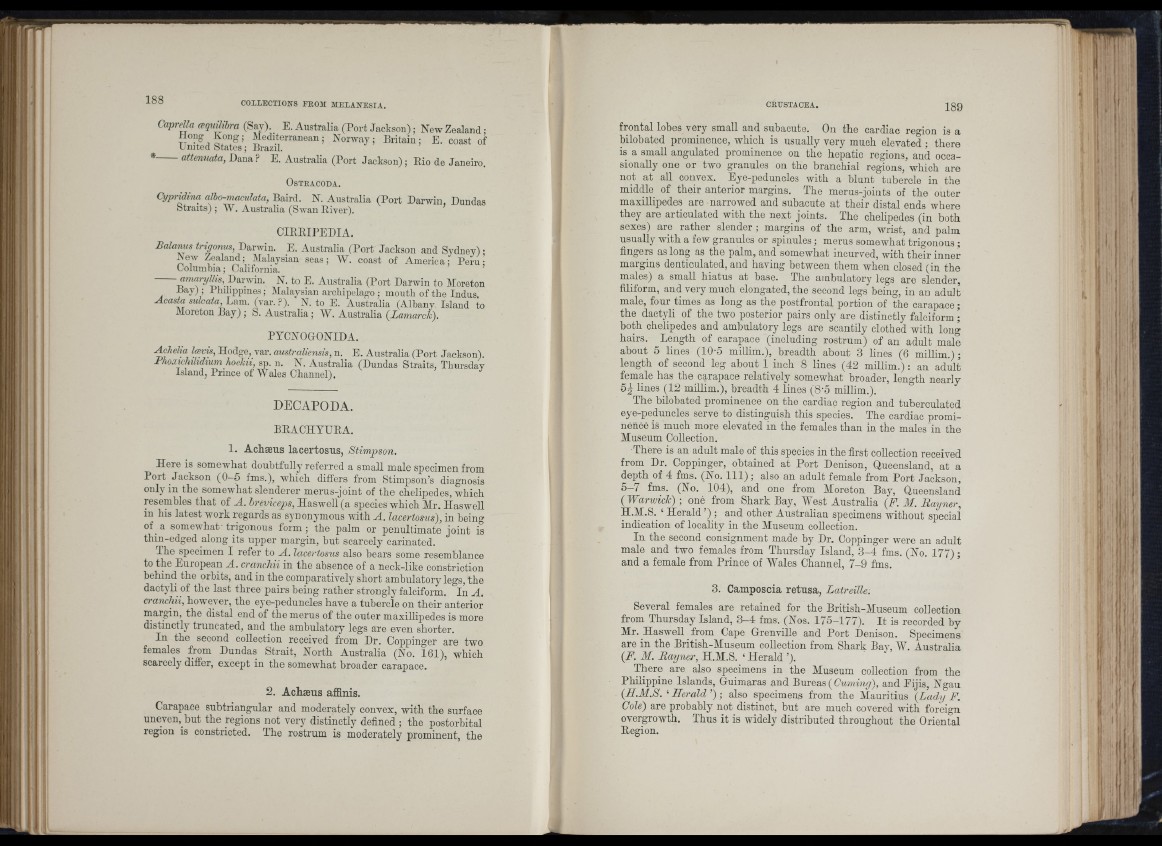
I t
Caprd/a æqnmhra (Say). E. Australia (Port Jackson) ; New Zealand ;
Hong Kong-; Mediterranean; Norway; Britain; E. coast of
United States ; Brazil.
* attennata, Dana P E. Australia (Port Jackson) ; Rio de Janeiro.
OSTEACODA.
Cypridina alho-mamJata, Baird. N. Australia (Port Darwin, Dundas
Straits) ; W. Australia (S wan River).
CIRRIPEDIA.
Balanm trigonus, Darwin. E. Australia (Port Jackson and Sydney) •
New Zealand; Malaysian seas; W. coast of America; Peru;
Columbia; Oaiifoniia.
amanjllis, Darwin. N. to E. Australia (Port Darwin to Moreton
Bay); Philippines; Malaysian archipelago ; mouth of the Indus.
Acasta sulcata, Lam. (var. ?). N. to E. Australia (Albany. Island to
Moreton Bay) ; S. Australia ; AV. Australia (Lamarck).
PYCNOGONIDA.
xHhelia Iceyis, Hodge, var. australiensis, n. E. Australia (Port Jackson).
1 hoawhilidium hoekii, sp. n. N. Australia (Dundas Straits, Thursday
Island, Prince of AVales Channel).
DECAPODA.
BRACHYURA.
1. Achæus Ïacertosus, Stimpson.
Here is somewhat doubtfully referred a small male specimen from
Port Jackson (0 -5 fms.), whieh differs from Stimpson’s diagnosis
only in the somewhat slenderer merus-joint of the chelipedes, which
resembles th a t of A . hreviceps, Haswell (a species which Mr. HasweU
in his latest work regards as synonymous with A . ïacertosus), in being
of a somewhat-trigonous form; the palm or penultimate joint is
thin-edged along its upper margin, but scarcely carinated.
The specimen I refer to A . ïacertosus also hears some resemblance
to the European A . crancMi in the absence of a neck-like constriction
behind the orbits, and in the comparatively short ambulatory legs, the
dactyli of the last three pairs being rather strongly falciform. In A .
cranchii, however, the eye-peduneles have a tubercle on their anterior
rnargin, the distal end of the merus of the outer maxillipedes is more
distinctly truncated, and the ambulatory legs are even shorter.
In the second collection received from Dr. Coppinger are two
females from Dundas Strait, North Australia (No. 161), which
scarcely differ, except in the somewhat broader carapace.
2. Achæus affinis.
Carapace subtriangular and moderately convex, with the surface
uneven,_but the regions not very distinctly defined ; the postorbital
region is constricted. The rostrum is moderately prominent, the
frontal lobes very small and subacute. On the cardiac region is a
bilobated prominence, which is usually very much elevated ; there
is a small angulated prominence on the hepatic regions, and occasionally
one or two granules on the branchial regions, which are
not a t all convex. Eye-peduncles with a blunt tubercle in the
middle of their anterior margins. The merus-joiiits of the outer
maxillipedes are narrowed and suhacute at their distal ends where
they are articulated with the next joints. The chelipedes (in both
sexes) are rather slender ; margins of the arm, wrist, and palm
usually with a few granules or spinules; merus somewhat trigonous ;
fingers as long as the palm, and somewhat incurved, with their inner
margins denticulated, and having between them when closed (in the
males) a small hiatus at base. The ambulatory legs are slender,
filiform, and very much elongated, the second legs being, in an adult
male, four times as loug as the postfrontal portion of the carapace;
the dactyli of the two posterior pairs only are distinctly falciform ;
both chelipedes and ambulatory legs are scantily clothed with long
hairs. Length of carapace (including rostrum) of an adult male
about 5 lines (10-5 millim.), breadth about 3 lines (6 millim.);
length of second leg about 1 inch 8 lines (42 millim.) : an adult
female has the carapace relatively somewhat broader, length nearly
5 | lines (12 millim.), breadth 4 lines (8 ’5 millim.). °
The bilobated prominence on the cardiac region and tuberculated
eye-peduncles serve to distinguish this species. The cardiac prominence
is much more elevated in the females than in the males in the
Museum Collection.
There is an adult male of this species in the first collection received
from Dr. Coppinger, obtained at Port Denison, Queensland, at a
depth of 4 fms. (No. I l l ) ; also an adult female from Port Jackson,
5 -7 fms. (No. 104), and one from Moreton Bajq Queensland
(Wcirwick) ; one from Shark Ray, AVest Australia (F. AI. Rayner,
H.M.S._ ‘ Herald ’) ; and other Australian specimens without special
indication of locality in the Museum collection.
In the second consignment made by Dr. Coppinger were an adult
male and two females from Thursday Island, 3 -4 fms. (No. 177);
and a female from Prince of A^*ales Channel, 7-9 fms.
3. Camposcia retusa, Latreille.
Several females are retained for the British-Museum collection
from Thursday Island, 3 -4 fms. (Nos. 175-177). I t is recorded by
Mr. Haswell from Cape Grenville and Port Denison. Specimens
are in the British-Museum collection from Shark Bay, AV. Australia
(F. AI. Rayner, H.M.S. ‘ Herald ’).
There are also specimens in the Aluseum collection from the
Philippine Islands, Guimaras and Lxrceas, (Cuming), and Pijis, Ngau
(H.Al.S. '■Herald’); also specimens from the Mauritius (Lady F.
Cole) are probably not distinct, but are much covered with foreign
overgrowth. Thus it is widely distributed throughout the Orienfal
Region.
j! i;
¡' j
p . ill J ■ f *
4i l '! 4' it i !i I.
‘ i t I I '
'i .1'
I I ' l i
■:l\ . I
r . ii